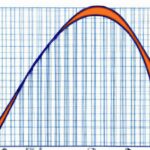The Lorenz curve shows income distribution but overlooks individual changes over time. Critics point to this as a limitation. Critics argue that the curve assumes income distribution remains constant. However, real-life is not static. People’s incomes change, thus affecting distribution. Critics also highlight that the curve doesn’t account for factors like inflation and social policies which impact income distribution. These limitations can lead to overgeneralizations. Despite its visual appeal, the Lorenz curve is not immune to criticism. Understanding its limitations can aid in a more comprehensive analysis of income distribution trends.
Table of Contents
- Assumptions made
- Data limitations
- Economic factors not captured
- Interpretation challenges
- Policy implications
(Gini Coefficient and Lorenz Curve)
The Lorenz curve is a useful tool for understanding income inequality, but it has limitations. Critics argue that it oversimplifies a complex issue. One key criticism is that it only shows a two-dimensional view of inequality. This can lead to a misunderstanding of the actual distribution of wealth. Another limitation is that the Lorenz curve is based on data that may not accurately represent the entire population. This can skew the results and provide a misleading picture of income inequality. Moreover, the Lorenz curve does not account for factors such as age, education, or occupation, which can significantly impact one’s income level. Critics also point out that the Lorenz curve does not provide information on the causes of income inequality, making it less useful for policymakers. Despite these limitations, the Lorenz curve remains a valuable tool for visualizing income distribution and highlighting disparities. It is essential to recognize these limitations when using the Lorenz curve and to supplement its findings with other data sources for a more comprehensive understanding of income inequality.
Assumptions made
When delving into the intricate world of the Lorenz curve, it’s crucial to shed light on the assumptions made along the way. These assumptions can sometimes act as a double-edged sword, guiding our understanding while also potentially blurring our vision.
One assumption that often comes under scrutiny is the homogeneity of groups within society. The Lorenz curve operates under the premise that individuals within a specific group share similar characteristics and economic behaviors. But we all know that society is a melting pot of diversity – different backgrounds, beliefs, and ambitions intersecting at every turn.
Another assumption lies in the idea of income redistribution. The Lorenz curve assumes that redistributing income among individuals will directly impact their economic status without accounting for external factors such as access to resources or systemic barriers entrenched in society.
As we navigate through these assumptions, it’s easy to see how they can simultaneously illuminate and distort our perceptions of wealth distribution. They serve as pillars upon which theories are built but also as blinders that limit our scope of understanding.
Critics argue that these assumptions oversimplify complex societal dynamics by painting an incomplete picture of reality. They stress the importance of considering nuances like intergenerational wealth transfer, cultural influences on spending habits, and structural inequalities when analyzing income distribution patterns.
Despite these limitations, acknowledging assumptions allows us to approach the Lorenz curve with a critical lens – questioning its validity in diverse social contexts and prompting discussions on how best to refine existing models for more accurate representation.
In essence, dissecting assumptions made in relation to the Lorenz curve invites us into a realm where skepticism meets curiosity – where we challenge conventional wisdom while seeking deeper insights into socioeconomic disparities around us.
Data limitations
When delving into the realm of data limitations concerning the Lorenz curve, one must traverse a terrain fraught with challenges and intricacies. Often hailed for its ability to visually encapsulate income inequality within a society, the Lorenz curve is not without its imperfections. One of the primary hurdles encountered when utilizing this graphical representation arises from inadequate or inaccurate data collection methods.
Imagine standing at the edge of a vast lake, seeking to capture its essence using only a small jar – such is the analogy that befits working with limited or flawed data in constructing Lorenz curves. The accuracy and reliability of these curves hinge entirely on the quality of information fed into their formulation. Should there be discrepancies in income reporting, misclassifications of socioeconomic status, or inconsistencies in sampling techniques, the resulting curve may paint an erroneous picture of wealth distribution within a population.
Feelings of frustration and disillusionment can quickly cloud researchers’ minds as they grapple with datasets riddled with gaps and biases. It’s akin to trying to solve a complex puzzle with missing pieces; no matter how adept one is at assembling fragments, an incomplete picture will always emerge.
Moreover, another facet adding layers to this conundrum lies in the temporal aspect of data collection. Socioeconomic landscapes are dynamic entities constantly evolving under myriad influences like economic policies, global events, and technological advancements. Thus, relying on static datasets collected at discrete time points may offer but a fleeting glimpse into societal disparities while failing to capture shifts and trends over time accurately.
The weight of responsibility borne by researchers tasked with navigating these turbulent waters cannot be understated. They stand as custodians tasked with distilling raw data into meaningful insights that policymakers rely upon to draft inclusive strategies combating inequality effectively.
In conclusion, grappling with inherent data limitations when dissecting Lorenz curves serves as both a humbling reminder of our analytical constraints and an impetus for innovation in refining methodologies for capturing real-world complexities more accurately.
Economic factors not captured
When looking at the limitations and criticisms of the Lorenz curve, one significant aspect to consider is the economic factors that are not captured by this analytical tool. While the Lorenz curve provides valuable insight into income distribution within a population, it falls short in encapsulating certain intricate details.
Imagine a bustling city where wealth disparities run deep beneath the surface, hidden like buried treasure waiting to be unearthed. The Lorenz curve offers us a bird’s eye view of these discrepancies but fails to delve into the underlying reasons behind them. It paints a broad stroke picture without capturing the nuanced brushstrokes that define an economy.
One key economic factor often left out of the Lorenz curve analysis is intergenerational wealth transfer. Picture a family passing down riches through generations like a torch lighting up their path. This transfer of assets can significantly impact income distribution within society, yet remains overlooked by traditional measures like the Lorenz curve.
Another vital aspect sidelined by this method is non-monetary benefits and resources people possess. Consider communities rich in social capital — where relationships and networks hold more value than money itself. These intangible assets play a crucial role in shaping income inequality dynamics but go unnoticed when solely relying on quantitative data represented by curves and graphs.
Moreover, dynamic shifts in economies due to globalization or technological advancements are often omitted from Lorenz curve assessments. Imagine industries evolving overnight, leaving some job sectors obsolete while creating new opportunities elsewhere. Such rapid transformations redefine income structures within societies but are inadequately reflected in static representations offered by conventional economic models.
The intrinsic beauty of human diversity further complicates matters unaccounted for by simplistic tools like the Lorenz curve. Each individual brings unique skills, experiences, and aspirations to the table—factors influencing their earning potential beyond what any graph can portray accurately.
In essence, while the Lorenz curve serves as a fundamental tool for understanding income inequality at a glance, its limitations lie in overlooking complex economic realities that shape our modern world.
(Lorenz Curve and Gini Coefficient – Measures of Income Inequality)
Interpretation challenges
When delving into the realm of interpreting Lorenz curves, one encounters a myriad of challenges that can cast doubt on the accuracy and reliability of the data presented. One significant hurdle is the subjective nature of interpretation, as different analysts may infer varying conclusions from the same curve based on their assumptions and perspectives.
The intricate dance between income distribution and population segments portrayed in a Lorenz curve requires a keen eye to decipher correctly. The shape of the curve alone may not provide a comprehensive understanding; factors such as scale, axes intervals, and data granularity must be carefully considered to draw meaningful insights.
Moreover, issues arising from data quality pose another obstacle in accurate interpretation. Inaccurate or incomplete data input can skew results significantly, leading to misguided interpretations that fail to capture the true essence of income inequality within a given population.
Emotions run high when grappling with these interpretative challenges—frustration at elusive patterns, curiosity driving further exploration, skepticism towards seemingly contradictory findings. Each fluctuation in the curve’s trajectory stirs up emotions akin to riding a rollercoaster of analytical rigor and uncertainty.
Adding fuel to this interpretative fire is the inherent limitation of static representations offered by Lorenz curves. These snapshots frozen in time might not encapsulate dynamic shifts or trends occurring over periods—a critical factor demanding cautious consideration when drawing overarching conclusions about income disparities.
Navigating through these murky waters demands both artistry and precision—an ability to blend empirical evidence with theoretical frameworks while acknowledging the limitations inherent in any statistical model. It’s akin to piecing together fragments of an intricate puzzle where each observation contributes uniquely to painting a holistic picture despite its complexities.
As analysts wrestle with these challenges head-on, an air of resilience permeates their efforts—the unwavering determination to unravel hidden truths buried beneath layers of numerical abstractions fuels their pursuit for clarity amidst ambiguity. Each setback becomes an opportunity for growth and refinement rather than a roadblock impeding progress—a testament to human ingenuity persevering through intellectual adversities posed by interpreting Lorenz curves.
Policy implications
Policy implications stemming from the limitations and criticisms of the Lorenz curve hold significant weight in shaping societal equality. When we delve into these issues, a poignant realization surfaces – our current policy frameworks may not be equipped to address the nuances highlighted by critiques of this economic tool.
As we confront these challenges head-on, it becomes evident that relying solely on the Lorenz curve to gauge income distribution oversimplifies complex socio-economic dynamics. This oversimplification can lead to misguided policies that fail to target specific areas needing intervention most urgently.
One key consideration is reevaluating how we measure poverty and inequality. The shortcomings of the Lorenz curve underscore the need for more comprehensive metrics that capture various facets of deprivation beyond just income levels. By incorporating multidimensional measures of well-being, policymakers can craft more inclusive strategies tailored to uplift marginalized communities effectively.
Moreover, addressing structural barriers such as unequal access to education, healthcare, and employment opportunities is paramount in fostering equitable growth. Policies aimed at eradicating systemic inequalities must go beyond conventional economic indicators and tackle root causes perpetuating disparities across society.
In light of these insights, recalibrating social welfare programs emerges as a crucial step towards creating a fairer society. By integrating targeted interventions based on holistic assessments of individuals’ needs, governments can ensure resources are allocated where they will have the most profound impact.
Furthermore, enhancing transparency and accountability within governance structures is essential for mitigating corruption and ensuring equitable distribution of resources. Strengthening regulatory frameworks to monitor wealth accumulation among the elite can help prevent monopolization of assets at the expense of vulnerable populations.
Ultimately, navigating the complexities unearthed by criticisms surrounding the Lorenz curve demands a paradigm shift in policy formulation. Embracing inclusivity, equity, and social justice as guiding principles paves the way for crafting policies that resonate with diverse realities faced by people from all walks of life.













